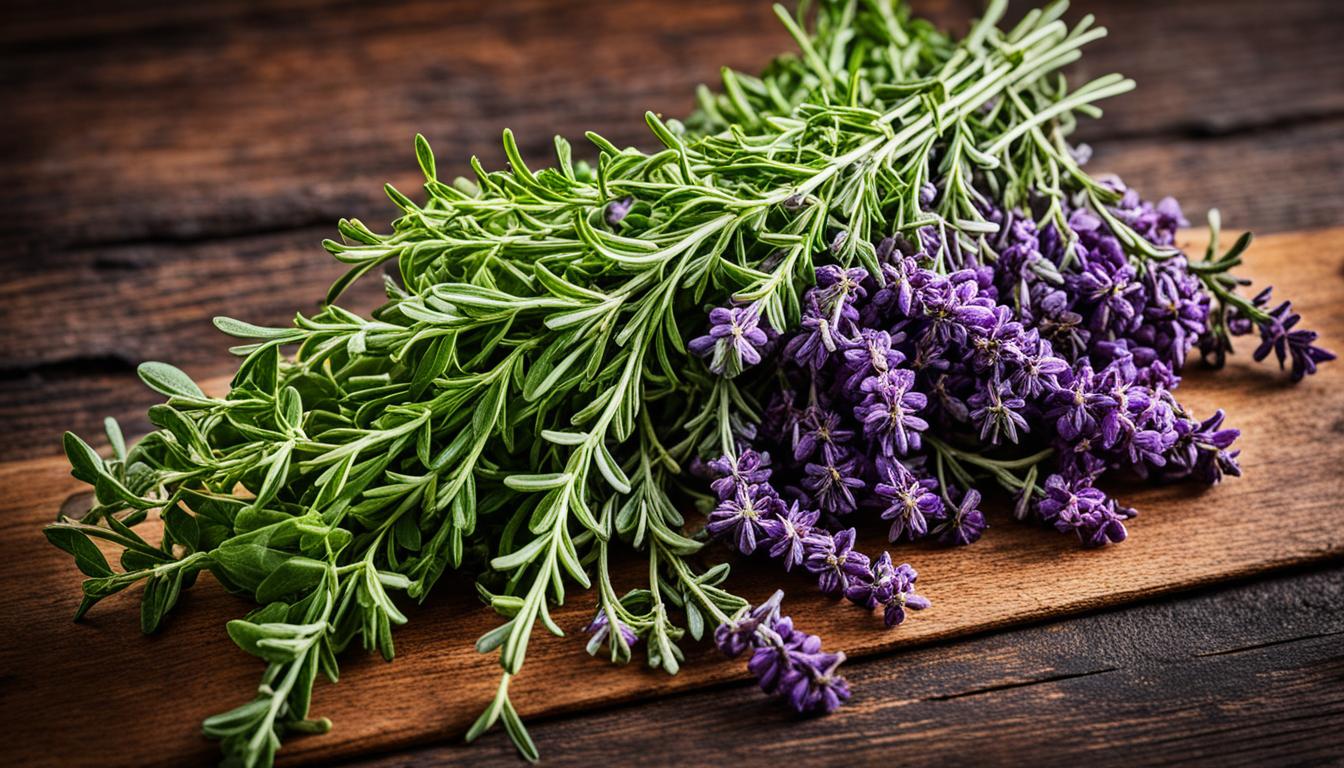I love cooking and always reach for thyme (Thymus vulgaris) for its smell and taste. This herb comes from the Mediterranean and is a key ingredient in my kitchen. It makes many dishes taste better and is good for our health too.
Thyme has been used for centuries for its healing, cooking, and smell. It adds a unique flavor to many dishes, from Mediterranean stews to European soups. It’s also known for fighting off bacteria and fungus, especially in the chest.
Exploring thyme has shown me how versatile it is in cooking and health. I use it to flavor chicken and make herbal tea. Thyme is a big part of my cooking and helps keep my family healthy. Let’s dive into the many uses and health benefits of this amazing herb.
Introducing the Aromatic and Flavorful Thyme
Thyme is a versatile herb that has won over culinary fans for centuries. It comes from the Mediterranean and is part of the mint family, like oregano. Its leaves are small and elliptical, gray-green on top and silvery underneath. This makes it a beautiful addition to any dish.
Origins and Varieties of Thyme
Thyme started in the Mediterranean basin, where it’s been used in cooking for thousands of years. It’s a perennial plant that grows well in many climates. This has made it very popular in European cooking.
There are about sixty different types of thyme, each with its own taste and smell. Some have zesty lemon flavors, while others have warm, citrusy notes. But the most common type used in cooking is French thyme. It’s known for its strong, earthy smell and can be used in many dishes.
| Variety | Flavor Profile | Typical Uses |
|---|---|---|
| French Thyme | Robust, earthy | Soups, stews, roasted meats and vegetables |
| Lemon Thyme | Zesty, citrusy | Fish, poultry, marinades, and salad dressings |
| Orange Thyme | Warm, citrusy | Baked goods, desserts, and herbal teas |
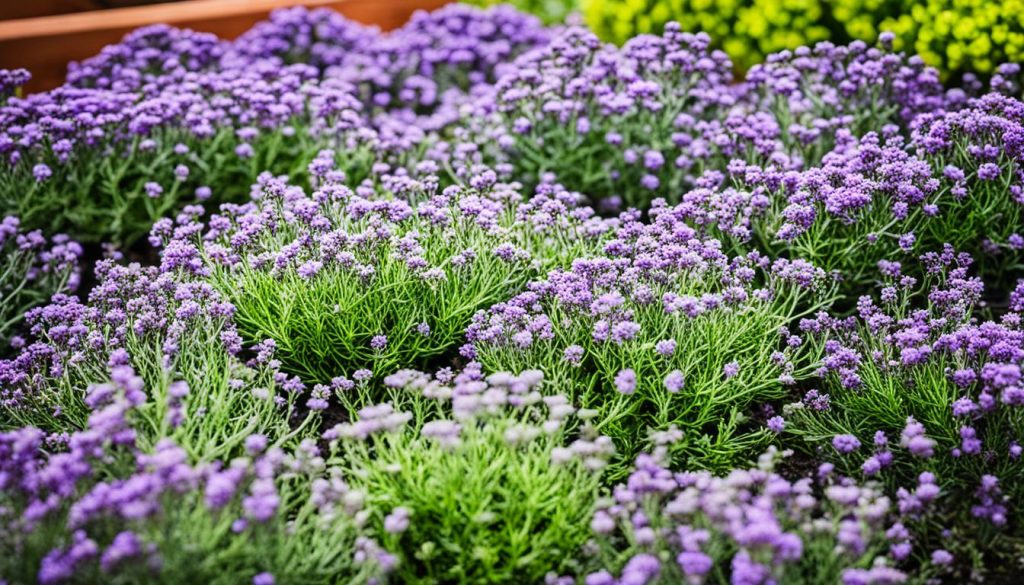
Thyme is a versatile herb that can add depth and complexity to a wide range of dishes, from savory stews to delicate baked goods.
Culinary Uses of Thyme
Thyme is a versatile herb that makes many dishes taste better. It has a savory flavor that fits well with Mediterranean and European foods. Thyme is a key part of the French “bouquet garni,” along with parsley and bay leaves.
Thyme in Mediterranean and European Cuisines
In Mediterranean cooking, thyme is used to season slow-cooked sauces and stews. It goes well with tomatoes, garlic, and olive oil. Thyme also adds flavor to pasta, eggs, and bean dishes.
Across Europe, thyme is a staple in many recipes. In Italy, it’s used in ragu, minestrone, and roasted veggies. In Spain, it’s a must-have in paella. In Greece, it’s used in the marinade for souvlaki.
| Culinary Uses of Thyme | Mediterranean Cuisine | European Cuisine |
|---|---|---|
| Slow-cooked sauces and stews | ✓ | ✓ |
| Braised meats | ✓ | ✓ |
| Pasta dishes | ✓ | ✓ |
| Egg preparations | ✓ | ✓ |
| Bean-based meals | ✓ | ✓ |
| Roasted vegetables | ✓ | ✓ |
| Paella | ✓ | |
| Souvlaki | ✓ |
Thyme is a versatile and flavorful herb in many savory dishes. It makes the taste and aroma of food better.
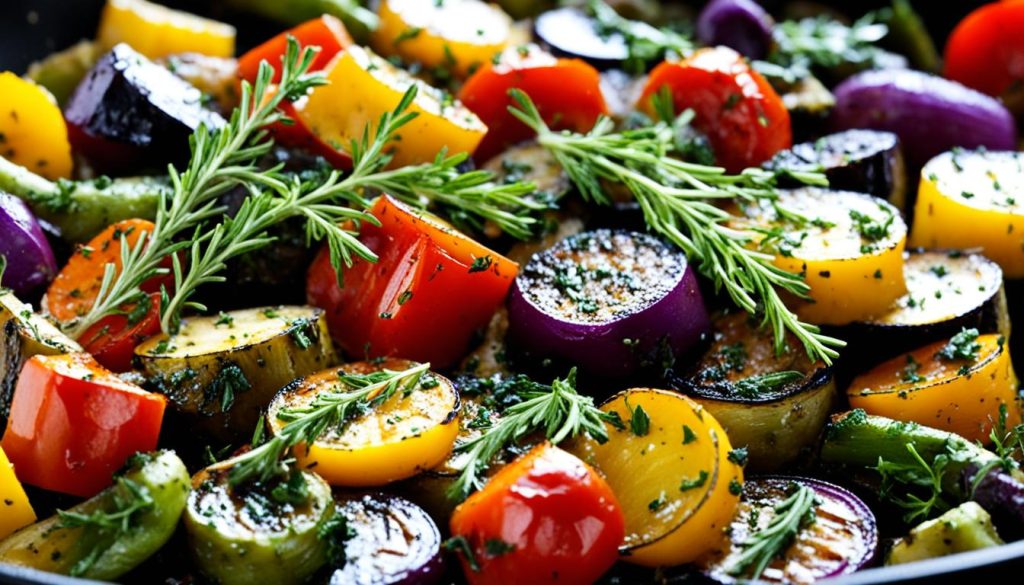
Health Benefits of Thyme
Thyme is more than just a tasty herb in the kitchen. It’s also packed with health benefits. For centuries, people have used it for its healing powers. Let’s look at how thyme can help us stay healthy.
Thyme is great because it fights bacteria and fungi. Research shows that thyme oil and extracts stop harmful bacteria from growing. This is good news for our lungs and throats, helping to fight infections and ease sore throats.
Thyme is also good for our stomach. It has compounds that help our digestion. These can make us hungrier and relieve indigestion.
Thyme is full of antioxidants too. These are substances that protect our cells from damage. Eating thyme can help keep us healthy and feeling good.
“Thyme has been used medicinally for its antibacterial and antifungal properties, particularly in regard to respiratory issues.”
Thyme can even be used on the skin to fight germs. It can be made into a mouthwash to soothe coughs and help with tonsillitis. The smell of thyme can calm our throat and lungs.
Adding thyme to our diet or skincare can be a smart move. It supports our lungs, stomach, and overall health. Thyme is a true gem in the world of plants.
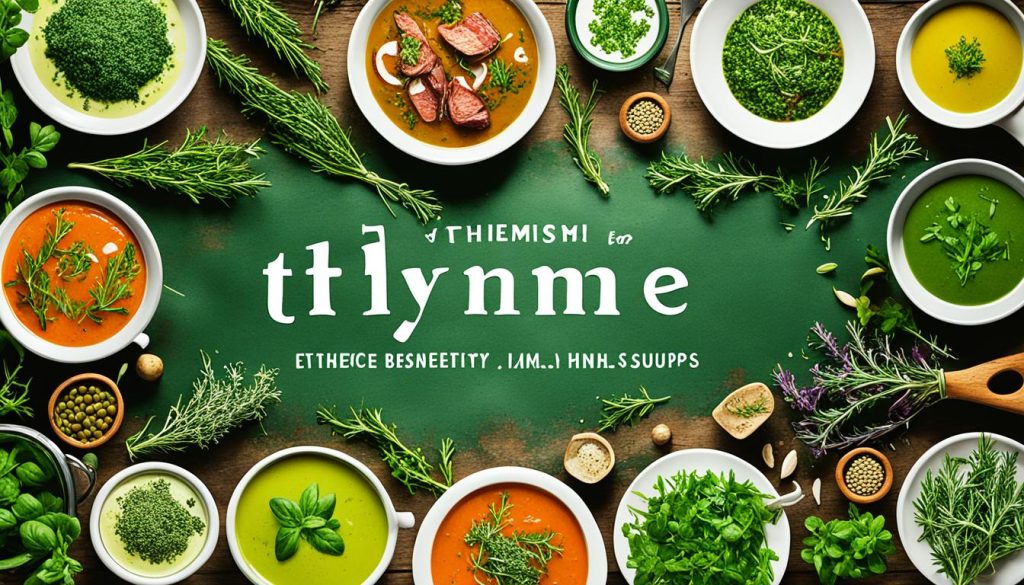
Thyme: A Natural Food Preservative
I love cooking at home and always look for new ways to make my food better. Thyme is not just for cooking; it’s also a natural way to keep food safe. It can clean produce of harmful bacteria, making salads and other raw dishes safer to eat.
Research shows thyme can kill harmful bacteria like Shigella in lettuce. Just adding a bit of thyme can make the lettuce safe to eat. This is great news for keeping us safe from foodborne illnesses, especially with fresh foods.
| Benefit | Explanation |
|---|---|
| Thyme as a food preservative | Thyme essential oils can effectively decontaminate produce and prevent bacterial contamination. |
| Thyme decontaminating produce | Studies have shown that thyme can eliminate harmful bacteria like Shigella from lettuce and other fresh foods. |
| Thyme preventing bacterial contamination | Adding thyme to uncooked dishes like salads and dressings can help ensure the safety of fresh produce. |
Thyme is a great choice for keeping our food safe with its strong antibacterial properties. By using thyme in our cooking, we can enjoy its great taste and keep ourselves healthy.
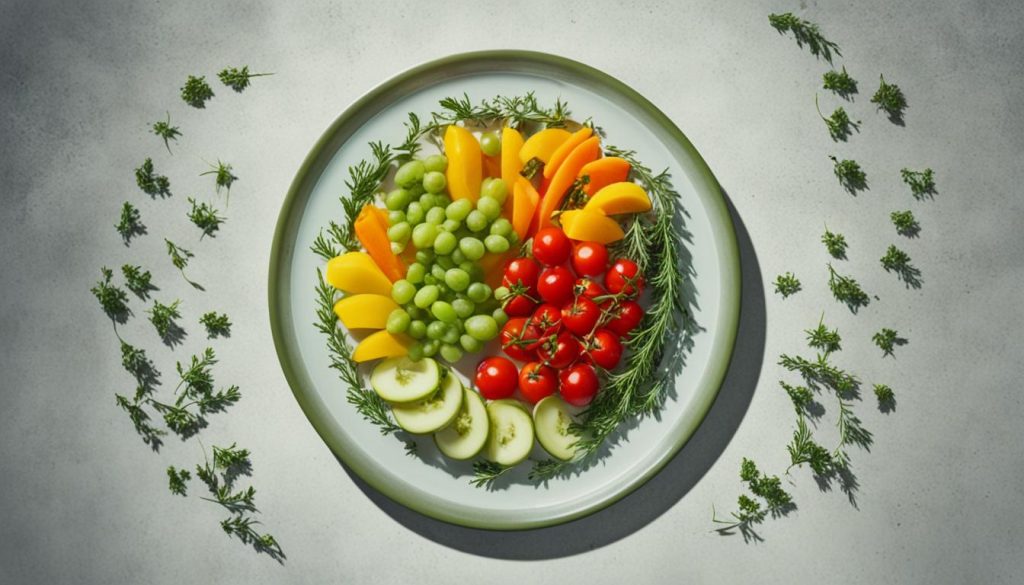
Thyme is a wonderfully versatile herb that not only enhances the taste of our food but also offers valuable health benefits. Its ability to decontaminate produce is truly remarkable and a testament to the incredible power of nature’s gifts.”
Nutrients and Antioxidants in Thyme
Thyme is full of nutrients like vitamins, minerals, and antioxidants. It’s a great source of iron, manganese, and vitamin K. This makes it a key herb for health.
Thyme as a Source of Iron, Manganese, and Vitamin K
Just one teaspoon of dried thyme has a lot of these important nutrients:
- Iron: Thyme gives you 1.7 mg of iron, which is 9% of what you need daily.
- Manganese: It has 0.2 mg of manganese, which is 8% of your daily need.
- Vitamin K: Thyme is a top source of vitamin K, giving you 12.5 mcg, or 10% of what you need.
Thyme is also packed with antioxidants, especially thymol. Studies show it helps protect cells and keeps them healthy.
Research also shows that eating thyme can boost healthy fats in your brain, kidneys, and heart. This highlights thyme’s many health benefits.
“Thyme is a nutrient-dense herb that offers a wealth of essential vitamins and minerals, making it a valuable addition to any healthy diet.”
Selecting and Storing Fresh and Dried Thyme
Thyme comes in fresh and dried forms, each with its own benefits. Choose fresh thyme with bright green-gray leaves that are spot-free and not yellow. Fresh thyme tastes more complex than dried thyme.
To keep fresh thyme, wrap the stems in a damp paper towel and refrigerate for a week. This keeps its smell and taste fresh. Dried thyme should be stored in an airtight container in a cool, dark spot for up to six months. It keeps its strong, earthy flavor.
Choosing between fresh and dried thyme depends on the recipe and what you like. Fresh thyme is great for sauces, marinades, and dishes where you want its fresh taste to stand out. Dried thyme is better for slow-cooked meals like soups and stews. Its strong flavor can make the whole dish taste better.
| Fresh Thyme | Dried Thyme |
|---|---|
| More aromatic and flavorful | Concentrated, earthy flavor |
| Lasts up to 1 week in the fridge | Shelf-stable for up to 6 months |
| Best for sauces, marinades, and fresh dishes | Ideal for slow-cooked meals like soups and stews |
Whether you like the fresh taste or the strong flavor of dried thyme, it’s a great addition to any kitchen. With the right way to pick and store it, you can enjoy all the benefits of this tasty herb.
Thyme in Recipes: Soups, Stews, and More
Thyme is a versatile herb that makes many recipes better. It’s great in soups, stews, sauces, and roasted veggies. It’s a key part of the French bouquet garni, adding flavor to classic dishes.
Thyme goes well with Mediterranean and European food. It brings out the best in slow-cooked sauces, meats, and veggies. I add thyme early to let its flavors fully develop.
Dr. Weil’s Recommendations for Using Thyme
Dr. Andrew Weil, an expert in integrative medicine, loves thyme in cooking. He uses it in sautéed mushrooms and roasted root veggies. Thyme’s earthy and minty taste is perfect with these foods.
Dr. Weil says to add thyme early in cooking. This lets its oils fully develop and add flavor. This way, thyme’s best flavors come out in the dish.
| Dish | How to Use Thyme |
|---|---|
| Sautéed Mushrooms | Add thyme at the beginning of cooking to allow its flavor to permeate the mushrooms. |
| Roasted Root Vegetables | Toss thyme with the vegetables before roasting to enhance their earthy, caramelized notes. |
| Soups and Stews | Include thyme in the bouquet garni or add it directly to the pot early in the cooking process. |
Using thyme in different recipes, like sautéed mushrooms and roasted veggies, opens up a world of flavors. It helps home cooks make dishes that are unforgettable.
Pairing Thyme with Other Herbs and Spices
Thyme is a versatile herb that goes well with many flavors. It has a warm, earthy taste that pairs well with herbs like basil, rosemary, and oregano. Thyme also goes great with spices like allspice, nutmeg, cloves, garlic, and lemon peel.
Thyme is perfect for many dishes, from stews and roasted veggies to baked goods and marinades. It balances and enhances other ingredients, making the flavors work together well.
When making Mediterranean dishes or trying new flavors, add thyme. It’s great for both sweet and savory dishes. Thyme is a key herb for any kitchen.

